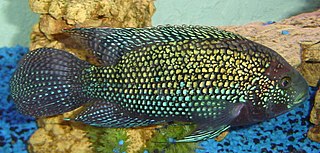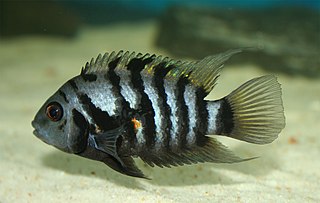
Astyanax is a genus of freshwater fish in the family Characidae of the order Characiformes. Some of these fish, like many of their relatives, are kept as aquarium pets and known collectively as tetras. With around 150 described species and new ones being described yearly, this genus is among the largest of the entire order; Hyphessobrycon also has more than 145 species and which one is larger at any one time depends on whether more species have been recently described in one or the other. The blind and colorless cave tetra of Mexico is a famous member of the genus, but its taxonomic position is disputed: Some recognize it as part of the Mexican tetra and this is supported by phylogenetic evidence, but others recognize the cave form as a separate species, A. jordani.

Maylandia or Metriaclima is a genus of haplochromine cichlids endemic to Lake Malawi in East Africa. They belong to the mbuna (rock-dwelling) haplochromines.

Paraneetroplus is a genus of cichlid fish native to moderately to fast-flowing waters in the Coatzacoalcos, Grijalva and Papaloapan river basins in southern Mexico. They reach up to 20–25.5 cm (8–10 in) in length.

Thorichthys is a genus of cichlid fish that is native to the Atlantic slope of Middle America, ranging from southern Veracruz and the Yucatán Peninsula in Mexico, to Guatemala and Honduras, with introduced populations in a few other countries. They tend to inhabit moderately-flowing to standing water such as rivers, streams, lakes, ditches and lagoons, and they are primarily freshwater fish, although T. helleri and T. meeki may occur in slightly brackish habitats.

Vieja is a genus of cichlid fish from Central America and Mexico. The majority of the species are freshwater fish found in stagnant or slow-moving waters of southern Mexico to El Salvador, but V. maculicauda, which also occurs in brackish waters, ranges south to Panama. They are high-bodied cichlids that reach lengths of up to 17–35 cm (7–14 in) depending on the exact species. Vieja feed mostly on vegetable matter, but may also take small invertebrates.

Archocentrus is a genus of cichlid fish from Central America. It currently contains a single species, the flier cichlid, which is found in stagnant and slow-moving freshwater habitats such as lakes, ponds, ditches, swamps and rivers in Honduras, Nicaragua and Costa Rica. It is up to 11 cm (4.3 in) long and feeds on invertebrates and detritus.

Amphilophus is a genus of cichlid fishes from Central America, ranging from southern Mexico to Panama. The genus currently contains 23 species, including several that are well known from the aquarium trade. However, studies led by Oldřich Říčan in 2008 and 2016 suggested that several species within Amphilophus should be moved to the genus Astatheros. Species proposed to be moved to Astatheros in 2008 were A. alfari, A. altifrons, A. bussingi, A. diquis, A. longimanus, A. macracanthus, A. margaritifer, A. rhytisma, A. robertsoni and A. rostratus. Further genetic studies led Říčan to put A. macracanthus in Astatheros, but to put A. alfari, A. altifrons, A. bussingi, A. diquis, A. longimanus, A. rhytisma, A. robertsoni and A. rostratus within the genus Cribroheros. Říčan's study suggests that the Astatheros species are more closely related to the Jack Dempsey and rainbow cichlid than to the remaining Amphilophus species.

Herichthys is a genus of cichlid fishes native to North and Central America. Most are endemic to Mexico, but H. cyanoguttatus is also found in southern Texas, and has been introduced to central Texas and Florida.

The Salvin's cichlid, also known as the yellow-belly cichlid or tricolored cichlid, is a species of the family Cichlidae. It is found in rivers of the Atlantic slope of southern Mexico, Belize, and Guatemala. It is the only species in the genus Trichromis.

The Cichlasomatinae are a subfamily of cichlid fishes, including all cichlids native to the Greater Antilles, United States, Mexico and Central America, and many of the cichlids from South America. The subfamily Cichlasomatinae is often divided into two tribes: Cichlasomatini and Heroini, however some authorities classify these two tribes as part of the wider Neotropical and marginally Nearctic subfamily Cichlinae.

Amatitlania is a genus of cichlid fishes native to freshwater habitats in Central America from El Salvador and Guatemala to Panama. They are fairly small cichlids, typically reaching up to 6.4–10 cm (2.5–4 in) in standard length depending on exact species, although captives may grow larger.

Cryptoheros is a genus of small cichlid fishes from Central America and southeast Mexico. They reach up to 13 cm (5.1 in) in length.

Heroini is a fish tribe from the Cichlasomatinae subfamily in the family Cichlidae (cichlids). All cichlids native to the Greater Antilles, United States, Mexico and northern Central America are members of this tribe. It also includes most cichlid species in southern Central America and several species from South America. A large percentage of its species were formerly placed in the genus Cichlasoma but have since been moved to other genera.

Herichthys pantostictus, the Chairel cichlid or Atezca cichlid, is a species of cichlid native to the Panuco River drainage of Mexico's Atlantic coast where it is mostly found in moderately fast flowing rivers, slightly brackish, murky lakes and lagoons along the coast. A lacustrine form, formerly described as Herichthys molango and endemic to "Laguna Atezca" in the municipality of Molango, has now been extirpated by introduced species. The species reaches a maximum size of 12.6 centimetres (5 in) SL though most do not exceed 5.6 centimetres (2.2 in), and can also be found in the aquarium trade.
The Cichlid Room Companion (CRC) is a membership-based webpage dedicated to the fishes of the Cichlid family (Cichlidae). The site was launched in May 1996 and offers arguably the most comprehensive authoritative catalogue of cichlids on the web, which is illustrated with more than 25,000 photographs of fishes and 2,000 of habitats, as well as over 300 videos of cichlids and their habitats. It also “offers access to ample information about 253 genera and 2371 species”, a discussion forum as well as many articles about taxonomy, natural history, fish-keeping, field accounts, conservation, and other cichlid related topics; mostly written by citizen scientists and people who specialize in cichlids. The species summaries provided in the form of profiles include taxonomic, distribution and habitat, distribution maps, conservation, natural history, captive maintenance, images, videos, collection records, and an extensive bibliography of the species included and have been prepared by world-class specialists. A document establishes the standards followed in the preparation and maintenance of the cichlid catalogue. The site is administered by its creator and editor, Juan Miguel Artigas-Azas, a naturalist, who is also an aquarist and a nature photographer. In 2008, the American Cichlid Association (ACA) awarded Artigas-Azas the Guy Jordan Retrospective Award, which is the maximum honor that association gives to people who have done extensive contribution to the international cichlid hobby.

Maskaheros is a genus of cichlids fish found on Atlantic slope of southern Mexico and Guatemala in the Coatzacoalcos and Usumacinta River drainages. They are relatively large, high-bodied cichlids and were formerly included in the genus Paraneetroplus or Vieja.
Kihnichthys ufermanni, the Usumacinta cichlid, is a species of cichlid found in a few rivers in the Usumacinta River basin in Guatemala and southern Mexico. It typically occurs in rivers that are about 10–50 m (33–164 ft) wide, fairly deep, have few or no aquatic plants, and a variable water current. This species is the only known member of its genus, but several of its features, including the chisel-like teeth, are shared with Cincelichthys and whether they should be merged into a single genus is not yet fully resolved; a review in 2020 recommended that the Usumacinta cichlid should be moved into Cincelichthys. The Usumacinta cichlid reaches a standard length of 25 cm (10 in).

Cincelichthys is a genus of high-bodied cichlids found in southern Mexico to Guatemala, where they inhabit lakes, rivers and other freshwater habitats. They are large cichlids, up to 35–42.5 cm (14–17 in) long depending on species, with females reaching smaller sizes than males.

Mayaheros is a genus of cichlid fish that is native to Mexico and northern Central America. This genus has a disjunct distribution, with the M. urophthalmus group being found in the Atlantic drainages of southeastern Mexico, Belize, eastern Guatemala, northern Honduras and northeastern Nicaragua, while M. beani is the northernmost cichlid in the Pacific drainage, ranging from Jalisco to Sonora in northwestern Mexico. Both inhabit a wide range of habitats such as freshwater rivers, streams, lakes, ponds, pools and marshes, as well as brackish waters like estuaries, lagoons and mangrove, with members of the M. urophthalmus group sometimes even occurring in caves or coastal marine waters. They are medium-sized to large cichlids that are omnivorous, feeding mostly on small animals, but also plants and detritus.

Astyanax caballeroi is a small species of freshwater fish endemic to a single lake system in Mexico. It has a longer snout and more slender body than most other species in the genus Astyanax, thought to be the result of predatory behavior; while A. caballeroi eats invertebrates and smaller fish, other Astyanax species are more broadly omnivorous, and have deeper bodies with shorter snouts. This difference in body shape once placed A. caballeroi, along with several other species of Astyanax, into the former genus Bramocharax.

















